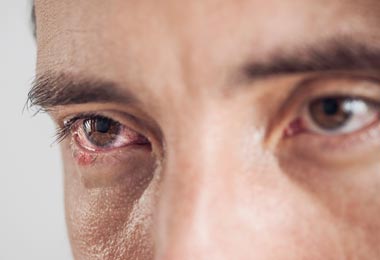Fuchs' Dystrophy
Reviewed By:
What You Need to Know
- Fuchs’ dystrophy is caused by deteriorating corneal cells and can lead to corneal edema.
- Blurred vision in the morning is one of the first signs of Fuchs’ dystrophy.
- Treatments range from eyedrops or ointments to corneal transplant surgeries.
What is Fuchs’ Dystrophy?
Fuchs’ dystrophy is a genetic disease affecting the cornea. Although a patient is born with the condition, it is not detectable or symptomatic until middle age or later. During the disease’s progression, the layer of cells (endothelium) responsible for maintaining proper fluid levels in the cornea will deteriorate and cause tiny bumps (guttae) to form on the back of the cornea. When enough cells are lost, fluid builds up in the cornea, resulting in swelling. This swelling, called corneal edema, causes clouding or blurring of vision.
Symptoms of Fuchs’ Dystrophy
One of the first signs of Fuchs’ dystrophy is blurred vision, caused by fluid buildup in the cornea. In early stages of the disease, the excess fluid builds up overnight during sleep, causing blurry vision and/or discomfort when waking in the morning. This may last for hours. The excess fluid can be drawn out of the cornea over the course of the day, reducing the swelling and improving vision.
In the advanced stage of Fuchs', the periods of swelling, impaired vision and discomfort last longer, even up to the entire day.
Other symptoms include:
- Rough or gritty feelings in the eye, occasionally accompanied by sharp eye pains
- Discomfort in bright light
- Fluctuating eyesight throughout the day or day to day, which is usually worse in the morning or on humid, rainy days
- Halos and/or glares from bright lights
- Blurry vision combined with poor contrast in colors
Diagnosis of Fuchs’ Dystrophy
Fuchs’ dystrophy is often diagnosed during a routine eye exam. Your eye doctor may perform the following tests to confirm a diagnosis.
- Slit lamp microscopy: The slit lamp produces a beam of light that can be adjusted from a thin slit to a round circle, depending on what part of the eye the doctor wants to see. The attached microscope allows structures of the eye to be seen with high magnification.
- Pachymetry: The pachymeter, which measures corneal thickness, is useful in detecting disorders such as Fuchs’ dystrophy that cause the cornea to thicken.
- Confocal/specular microscopy: A confocal/specular microscope projects light to allow photography of the corneal endothelium. It can measure the number, density and shape of the endothelial cells.
Treatment of Fuchs’ Dystrophy
While current therapies cannot reverse Fuchs' dystrophy, early stages of the disease may be treated with nonsurgical solutions such as eyedrops or eye ointment.Advanced Treatment
If the disease advances and causes impairment of regular activities, your physician may suggest surgical interventions such as:
- Corneal transplant surgery
- Endothelial keratoplasty. During this particular form of corneal transplant surgery, portions of the cornea affected by Fuchs’ dystrophy — the corneal endothelium and Descemet’s membrane — are replaced with healthy corneal tissue from an organ donor. Types of endothelial keratoplasty that are commonly performed include Descemet stripping automated endothelial keratoplasty (DSAEK) and Descemet’s membrane endothelial keratoplasty (DMEK).
Fuchs' Dystrophy and Cataracts
Patients with Fuchs’ dystrophy may also develop cataracts (link to cataract HL). In cases of mild or moderate Fuchs’ severity with cataracts, cataract surgery may be the only recommended treatment. Following cataract surgery, corneal transplant (link to HL) may be necessary if:
- Recovery is slow or limited following cataract surgery.
- Fuchs' dystrophy condition worsens following surgery.
In cases of advanced Fuchs’ dystrophy, both cataract surgery and a corneal transplant may be recommended at the same time. By using a combined approach, patients benefit from a shorter overall recovery time.
Your ophthalmologist will recommend a treatment plan based on a thorough evaluation.
Fuchs' Dystrophy and Vision Correction Surgery
Patients with Fuchs’ dystrophy are advised against undergoing elective laser vision correction. The weakened condition of the cornea can worsen and affect the outcome of the treatment.






